An effort to recapitalise the Northrop Grumman E-8C Joint Surveillance Target Attack Radar System (JSTARS) with a modern business jet is shaping up to be this summer’s blockbuster defence programme, with three solid industry teams now vying for the $6.5 billion prize and Raytheon working on a curious new airborne radar called “Skynet”.
Northrop (the incumbent prime contractor), Lockheed Martin and Boeing have competing JSTARS proposals and are in a “blackout period” with no communication with the US Air Force as it decides whether to put two or all three teams on contract for an 11-month “pre-development” risk-reduction programme. The decision is expected in late August or early September, the air force says, and the main downselect to a single design will occur in late 2017.
JSTARS Recap, as the programme is known, officially started this year and aims replace the air force’s 16 large and expensive 707-300-based E-8C ground-looking battle management, surveillance and moving target indicator aircraft with 17 militarised business-class aircraft by 2026.

Northrop Grumman G5 JSTARS demonstrator flies into Melbourne, Florida
Northrop Grumman
At Northrop, this is seen as a must-win competition and it represents more than just a large business opportunity. The company practically invented JSTARS and owns the original patent. Now, it is being forced to defend that position and must fend off Lockheed and Boeing to retain its hold on the mission.
The company has expected this requirement for some time. Several years ago it purchased a Gulfstream G5 demonstrator jet that is “550 representative” as a testbed aircraft to trial new radars and mission systems, while also showing the government what is possible.
Flightglobal viewed the aircraft, which carries the G550 tag on its tail, at the company’s Manned Aircraft Design Center of Excellence in Melbourne, Florida – which is considered the birthplace of the E-8, even though the operational fleet is based about 500 miles north at Robins Air Force Base in Georgia.
Northrop is the only prime contractor to have assembled a dedicated JSTARS demonstrator, which it says is a “70% solution”.
Northrop – or Grumman more specifically, before it was acquired – has been in the JSTARS business since before the programme started in 1985.
The company has everything to gain by retaining JSTARS, and everything to lose should this next version fall to its rivals, Lockheed or Boeing.
The air force has invested approximately $20 billion in the radar-carrying platform since its inception, and the recapitalisation is estimated to be worth another $6.5 billion.
“We are the domain experts,” Alan Metzger, Northrop’s vice-president and programme lead for next-generation JSTARS, said on the tour. “We have been in this mission area for 30 years and have built a tremendous partnership with the air force, and we think it’s relevant in tomorrow’s fight. If the air force wants to recapitalise, we don’t think there’s anybody in a better position to figure out how to help them do that.”
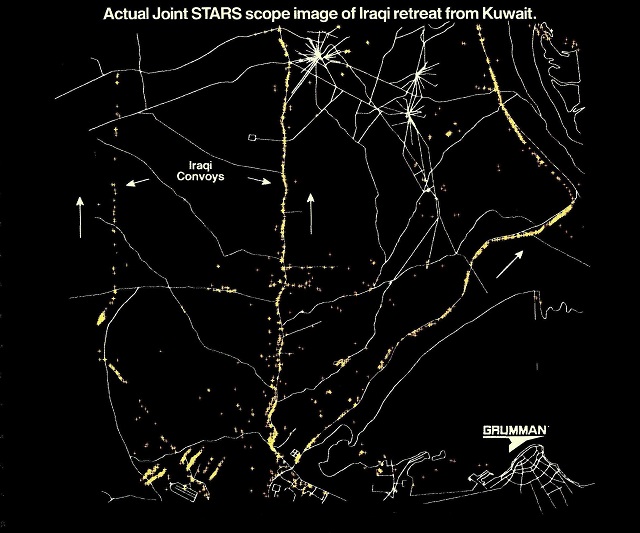
Iraqi convoys retreat from Kuwait City along the so-called Highway of Death in 1991
Flight International 1991
Bold history
Exactly what a JSTARS aircraft does is summed up in a Grumman advertisement printed in a 1991 copy of Flight International.
It shows what was famously labelled the “Mother of all Retreats” – columns of Iraqi armour fleeing north out of Kuwait City along the infamous “Highway of Death” into Basrah, Iraq.
With capabilities such as JSTARS monitoring this fatal mass movement from above, American and Canadian attack aircraft – as well as assault troops on the ground –swooped in and routed the fleeing Iraqi forces in what was a final, devastating blow that ended the war.
Operation Desert Storm was JSTARS’ baptism of fire, with two early prototype aircraft deployed to a base in Saudi Arabia to support the war effort.
With its 24ft phased array antenna and a dozen or so battle managers, JSTARS ushered in a new era of unprecedented situation-awareness for US forces.
The USAF purchased a relatively small fleet – just 17 operational aircraft (one crashed). The last one was delivered in 2005.
The two prototypes flew 54 combat sorties in the first Gulf War, and the fleet went on to notch up combat successes in Bosnia, Croatia, Afghanistan, Iraq and Libya, to name a few.
Lt Gen Robert Elder (retired), a former JSTARS pilot and commander of the 8th Air Force, says the aircraft really proved its worth during operational testing as part of the NATO air campaign in Bosnia in 1995.
“The Serbian air force was pounding on the Bosnians, the Croats,” he recalls. “[We] brought over NATO air power, and this is where they really found out how powerful JSTARS could be in terms of locating where they had troops.
“Any time the Serbians would mass for an attack, they would show up on JSTARS and it was easy to see. We would send NATO attack aircraft in so they could never, ever actually put together a force that was optimised to fight.”
Elder says JSTARS aircraft were used during the Global War on Terrorism in the 2000s to monitor Iraq’s porous borders with Syria, Jordan and Iran, as well as many other missions.
In Operation Enduring Freedom in Afghanistan, the aircraft provided convoy overwatch for the army and marine units until the armed MQ-1 Predator UAV assumed the role. It was also used to monitor patterns of life over vast distances, and it could tell where Taliban forces were crossing into Pakistan, and where their stop-off points were. “It’s about a 50,000km2 area you can cover at any one time,” says Elder, who is now a professor at George Mason University and a consultant to Northrop.
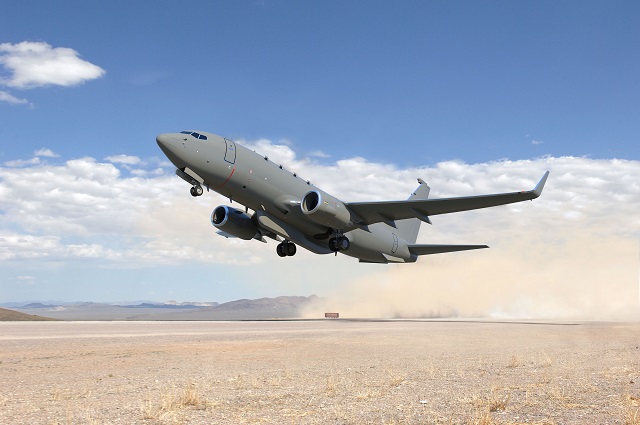
An artist’s impression of Boeing Defense, Space & Security’s JSTARS design, based on the commercial 737-700 BBJ1 aircraft
Boeing
It’s all about the aircraft
As successful as JSTARS has been on the battlefield, the programme has one fatal flaw: its aircraft are very, very old. So old, in fact, that the air force was looking to replace the second-hand, refurbished Boeing 707 freighters even before the final aircraft rolled off the line in 2005.
Using repurposed 707s that were already 20 to 30 years old turned out to be far less economical than imagined, and their antiquated engines were never replaced. A re-engining programme was aborted when the air force started exploring alternative aircraft options.
An analysis of alternatives in 2011 concluded that a modern, mid-size business-class jet that requires fewer crew members would be far cheaper to operate and maintain. Downsizing JSTARS would also open up new basing options, and allow the aircraft to deploy closer to their targets, whether that’s in Africa, Asia, the Middle East or Europe. The air force has not clearly articulated what size it would prefer, only saying “something between a Gulfstream 550 and Boeing 737-700”.
That is exactly what is on offer, and the choice of platform could potentially be where the battle is won or lost.
The primary considerations the air force will be looking at when assessing its platform options are cost, range, altitude, fuel consumption, radar interference from the aircraft – as well as basing options and how easily the aircrews could migrate to the new platform.
Northrop opted for a Gulfstream commercial business jet, and intends to offer the 550 unless the requirements shift considerably. The 650ER is also an option if the USAF requires longer range or more cabin space, but the 650 can’t carry as much weight. The 550 would be powered by two improved-performance Rolls-Royce engines, which give increased power over the standard commercial configuration.
“We did a risk-reduction study where we evaluated over 100 airplanes. We believe migrating the 707 to a Gulfstream-class business jet from a cost, risk and performance perspective yields the best opportunity,” Metzger says.
He says the 550 can climb to 41,000ft in 20min and its high-set engines and smooth undercarriage greatly reduce radar interference. Metzger says the size, weight and power of the radios and mission systems have reduced so much since the 1980s and 1990s that the 550 can carry everything the system needs.
Lockheed Martin intends to offer a Bombardier Global-series platform, which is comparable to the Gulfstream offering in terms of size, cost, performance and engine position.
“We cannot confirm the specific aircraft at this time, but we are working within the Bombardier product line to select the optimum aircraft,” Eric Hofstatter, Lockheed’s JSTARS Recap programme manager, said in a statement. He pointed to the Global series’ “affordable price, large cabin, high altitude and long endurance”.
Boeing comes to the table with the largest aircraft offering: a business jet from its 737 product line, the BBJ1, which combines the -700 fuselage with -800 wings for greater range and weight capacity. The company says the aircraft is only marginally larger tip-to-tip than the Gulfstream and Bombardier business jets, but has far more cabin space and can carry more weight.
“We meet or exceed every [draft] requirement,” says Rod Meranda, head of business development for Boeing’s next-generation JSTARS capture team. “We’re not trying to sell this as a growth airplane, but we’re trying to say it’s the right size airplane to minimise risk from the integration standpoint.”
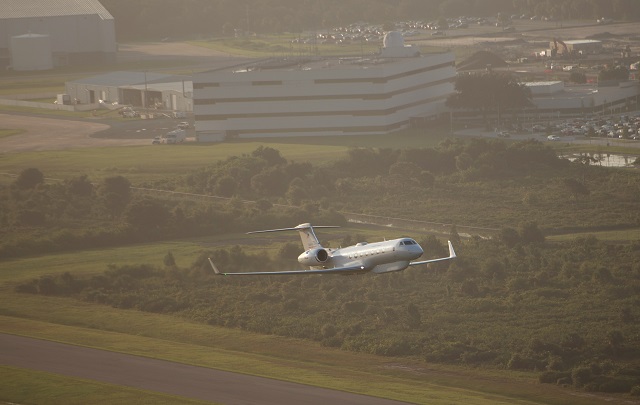
Northrop’s G5 JSTARS demonstrator flies from the company’s Manned Aircraft Design Center of Excellence in Melbourne, Florida
Northrop Grumman
Demonstrating capability
According to the air force’s latest JSTARS Recap schedule, two “green” test aircraft are required in the development phase for delivery by 2019.
Northrop has opted not to wait that long, and believes it could put a full-up prototype into the air much sooner.
The company has US Federal Aviation Administration-certified the radar canoe modification on its testbed aircraft, and has tried to limit changes to the commercial baseline wherever possible. Over the past year, the aircraft has visited Hanscom, Langley, Andrews and Robins air force bases and the commanders of Air Combat Command and US Air Forces in Europe (USAFE) visited the demonstrator in Melbourne, following the Air Force Association conference in Florida in February.
Hofstatter says the Lockheed team has not yet assembled a demonstrator, but is strongly considering investing in one prior to the start of the development. The company’s Skunk Works division is leading the charge, and has set up a system integration laboratory to test its radar and battle management components.
To date, Boeing has committed only to the air force’s development timeline of producing two test aircraft by 2019. Meranda says the company has a larger 767 testbed aircraft, but he doesn’t “see us putting up a full-up JSTARS system in the prototype configuration” prior to securing a development contract.
The air force has stated that it would like to see as many demonstrator aircraft flying as the companies are willing to pay for, but it’s not a requirement at this stage.
“I’d like to see 10 flying prototypes,” air force acquisition chief William LaPlante quipped at a recent Center for Strategic and International Studies (CSIS) event in Washington.
At the same event, though, LaPlante cautioned that while the air force is fully committed to the programme, it could be delayed if defence spending drops.
“We’re serious about it, but the real commitment the government is going to have to make is in about three years,” he says.
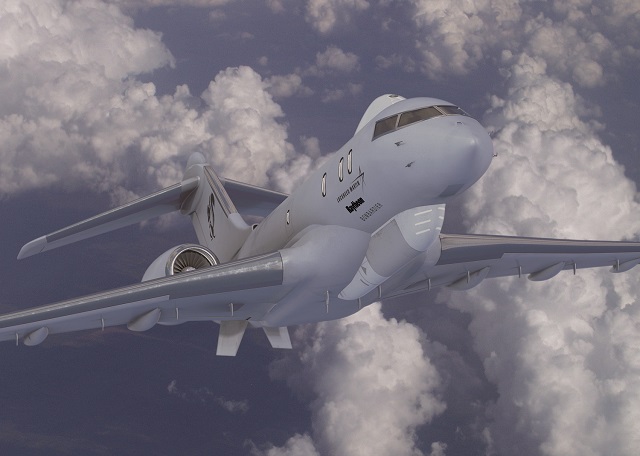
Lockheed Martin intends to offer a Bombardier Global-series aircraft fitted with Raytheon’s new Skynet AESA radar
Lockheed Martin
Skynet radar
As Northrop, Lockheed and Boeing battle for the prime contractor position, Raytheon is flying under the radar, so to speak, by offering it new “Skynet” radar to all sides. The company is in a non-exclusive partnership with Lockheed, but says it will offer its radar – believed to be a 16ft derivative of the Advanced Airborne Sensor (AAS) carried on the Boeing P-8 Poseidon maritime patrol aircraft – to whichever company wants it.
According to Raytheon: “Skynet incorporates the latest innovations developed for the US Navy’s stringent, wide-area surveillance requirements [and] meets or exceeds all JSTARS requirements for the lowest possible cost.”
Lockheed confirmed in a statement that it intends to carry Skynet on its business jet design, describing the radar as a “state-of-the-art active electronically scanned array (AESA), long-range, ground-surveillance radar”.
Northrop says it is closely examining Raytheon’s radar offering, but could also choose its own ground-looking AESA radar, depending on the final JSTARS requirements. Metzger’s team has been conducting trials with several different radar types at its radar test facility in Melbourne.
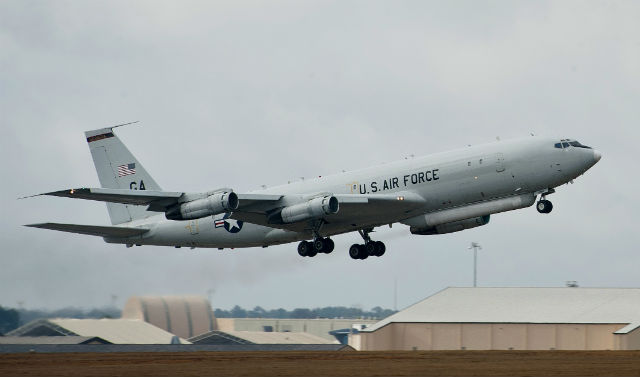
The legacy Northrop Grumman E-8C JSTARS is based on second-hand Boeing 707-300s
US Air Force
Going slow to go fast
According to the USAF’s fiscal year 2016 budget documents, the first two aircraft will be procured as part of the development contract due to be awarded in the fourth quarter of budget year 2017, and another three production-representative aircraft will be purchased later for initial operational capability in late 2023. In the interim, the air force expects to begin retiring E-8C aircraft, beginning in 2019 as the recap programme matures.
The last 12 aircraft will be delivered under a full-rate production contract for full operational capability in 2026.
This latest schedule represents about a one-year slip compared with an earlier draft schedule that was presented at an industry day in 2014.
Northrop believes it can go faster, and wants the air force reconsider its timeline.
The company has a head start as the original equipment manufacturer, and Metzger says his team has the infrastructure, personnel and know-how to deliver the E-8C replacement sooner, potentially avoiding upwards of $1 billion in costs over current estimates.
“Based on the maturity and the risk-reduction done to date, we think we can advance the schedule and have a significant amount of cost avoidance,” he says. “If you go faster, you save money. Our software is real, our people are knowledgeable, and we’re ready to go.”
LaPlante, however, contends that it is better to “go slow to go fast”.
He prefers to front-load a programme so that as much work as possible is done in the materiel solutions phase prior to the government committing to a significant, multibillion-dollar development effort.
“We’d like to get as many as three teams on programme, and get them working on risk-reduction activities. That’s where they’re funded by the government to continue the systems engineering flow down on identifying the high-risk items,” LaPlante says. “The ideal is to have three different companies at that point that have brought their solutions up to about a preliminary design review, and maybe even put their own money into a prototype. Then, when we’re ready to do the real programme, we have something really good to start with.”
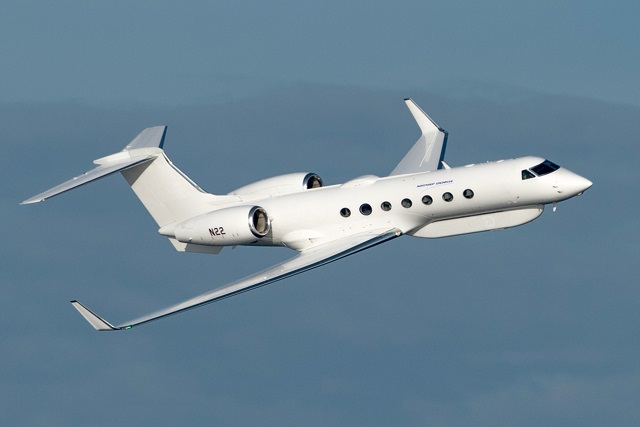
Northrop Grumman
Source: Flight International























